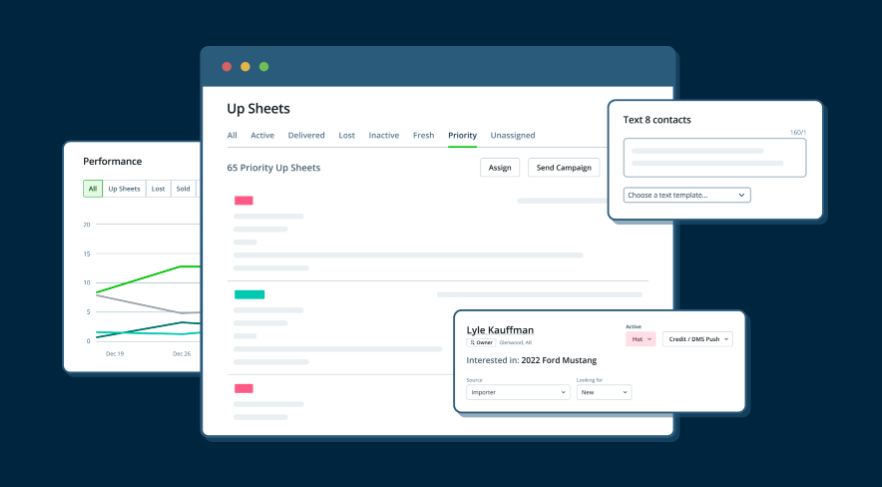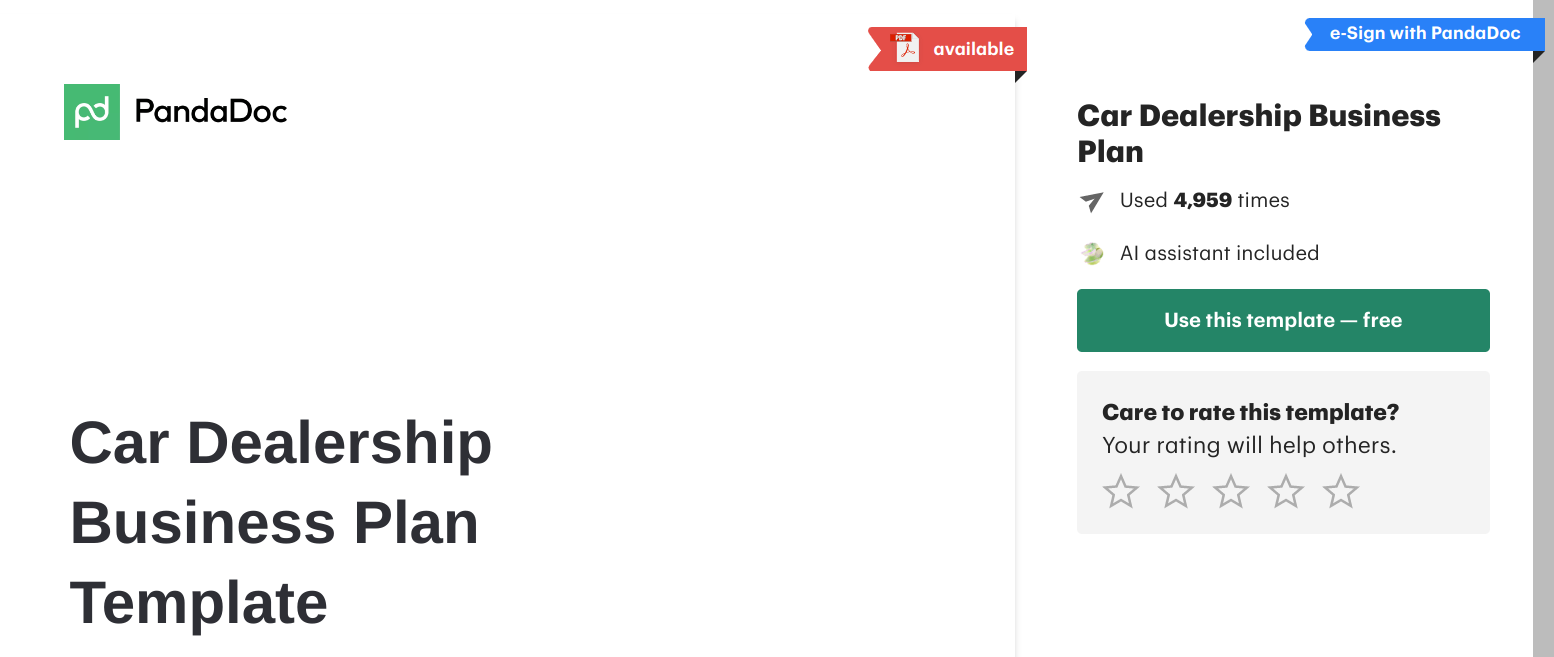- Blog
- Everything You Need to Know to Create a Business Plan for Your Used Car Dealership
Everything You Need to Know to Create a Business Plan for Your Used Car Dealership
Get started with your car dealership business plan: Simple and easy guide to building successful strategies for selling used cars.

Key takeaways
- A well-crafted business plan is essential for the success of your used car dealership. It’s your roadmap to guide your decisions, secure financing, and so much more.
- Conduct thorough market research and analysis to understand your target customers, competitors, and the overall market. This will help you make informed decisions and develop effective strategies.
- Carefully plan your initial investments in staff, inventory, equipment, and marketing to build a strong foundation for your dealership. Then, based on factors such as market demand, location, and target audience, choose the right business model.
- Your business plan should be structured. It should include essential sections such as the executive summary, company presentation, products and services, market analysis, strategy, and financial plan.
- Streamline your operations! Invest in your sales team, use inventory management tools, develop a car-sourcing strategy, and leverage business plan templates. Allocate sufficient marketing funds to reach and attract your target customers.
In this article, we'll show you everything you need to know to create a solid plan for your dealership, from setting goals to planning finances.
Whether you're new to the industry or an experienced trader, mastering this process is key to making your car dealership thrive.
Let’s start from the basics - why exactly do you need a business plan?
The primary purpose of a business plan is to help you figure out where you want to go with your car dealership business and how you’ll get there. It helps you determine a winning strategy to sell more cars.
What should your car inventory look like? How many people should you hire? Which marketing skills do you need, and how to proceed if marketing isn’t your strong point?
Worry not, eCarsTrade is here to make the entire process easier for your future dealership.
Business plan checklist - check if you have all the necessary information!
Before drafting your used car dealership business plan, it's important to have a clear picture of your market, legal setup, and operational needs. Use this checklist to make sure you've covered the essentials.
► Research and planning
-
Check licensing requirements – Every country has its own rules for becoming a licensed car dealer. Start with your national transport authority or local government site.
-
Study your local market – Look at what other dealers are selling, what types of cars are popular, and what buyers in your area are looking for.
-
Get location quotes – Compare costs for renting or buying a site where you can operate legally and attract customers.
-
Request insurance quotes – You’ll need coverage for liability, your inventory, and the property itself.
-
Explore financing options – Research local banks, leasing providers, or stock funding solutions to help you purchase vehicles.
-
Understand your tax setup – Learn how VAT, business tax, and import/export duties apply to your dealership.
-
Look into sourcing options – Will you buy from online auctions, lease returns, or import from other EU countries?
Importing vehicles from Europe can be complex, but eCarsTrade is here to simplify the process. Learn how to:
► Budget and costs
-
List your startup costs – Include everything you’ll need to get started: business registration, location setup, licensing, equipment, etc.
-
Estimate monthly expenses – Plan for rent, staff salaries, insurance, utilities, marketing, and other operating costs.
-
Know local car prices – Check the average selling prices for the types of cars you plan to offer.
-
Learn import/export basics – If you’ll source from outside your country, understand the paperwork, costs, and timelines involved.
-
Plan for seasonal changes – Demand can shift during the year. Consider how this will affect your cash flow and stock planning.
► Location and legal setup
-
Confirm your location is approved – Make sure your chosen premises are approved for car sales and meet local business requirements.
-
Understand EU consumer laws – Know your legal obligations when selling used cars, including returns, complaints, and disclosures.
-
Check environmental requirements – Some regions may require emissions control, oil/waste disposal processes, or other compliance measures.
-
Review hiring laws – If you’re hiring staff, understand local employment rules, contracts, and insurance.
-
Know cross-border rules – Learn what’s required to legally buy and sell cars across EU countries.
-
Understand warranty obligations – EU law sets minimum warranty standards for used vehicles, even for traders.
► Stock and operations
-
Choose what cars to sell – Focus on categories that perform well in your area (e.g. compact cars, vans, hybrids).
-
Check inspection/history rules – Some countries require vehicles to pass inspections or include full service history details before resale.
-
Plan your sourcing strategy – Research where and how you’ll consistently find the right vehicles (Germany, Belgium, Netherlands are top sources).
-
Prepare for import paperwork – Even within the EU, you’ll need to handle documentation correctly to register and sell imported cars.
-
Understand buyer preferences – Do local buyers prefer diesel, petrol, or electric? Certain brands? This affects what you should stock.
-
Set up quality control – Create a basic process to check and prepare every vehicle before listing it for sale.

Necessary business plan information for a used car dealership
Think of writing a business plan as your first investment in your car dealership. There is no need to complicate things; one page is more than enough.
You should put several steps to paper to create an overview of your dealership’s future. Below are the three most important ones.
1. Market research and analysis
Analyzing the market is more than just learning about your competitors and used car price ranges. Writing a business plan helps you think about the customers you are serving and their needs.
The branding of your dealership needs to showcase the fact that owning a used car is an affordable luxury, and the quality of your offered cars is the highest possible for the price you’re setting.
A business plan will help you think about your target market, your overall working budget, how much money you can set aside upfront to launch a used car dealership, and how your idea will actually work before you start spending any real money.
If there are already many used car dealerships in your area, you can look into wholesale or online models, which might help you stand out and attract an audience that will eventually become a loyal customer.
2. Initial investment - staff, inventory, equipment, marketing and more
Starting from scratch can be intimidating, especially if you don’t have a clear sense of what you might need in order to start a used car dealership.
What are the two things you immediately know you need? Cars and employees.
Training your salespeople is the easiest way to ensure a positive first impression with the customers. The next best thing is your inventory.
Inventory management is all about offering the right cars at the right time. Small dealerships benefit from cars that sell quickly or have a high demand in their target market.
Big dealerships can diversify their inventory to attract a wider range of customers but must be careful to avoid overstocking or neglecting niche markets.
Don’t forget to plan your equipment too. From office supplies, security equipment, and customer amenities, to actual tools for vehicle inspection, detailing, and necessary maintenance.
Once you deal with the basics such as photographing your inventory, you can already start promoting your business on various social media channels.
The initial investments for your used car dealership business can vary based on many different factors. You will need to look into types of insurance, operating expenses and educating your staff.
3. Define the business model of your dealership
Depending on market demands, location, target audience, and available resources, car dealerships can adopt several possible business models.
- Traditional retail model: your dealership buys a car from a manufacturer or a wholesaler, and sells the car to another dealership. Profit depends on available warranties, financing, and maintenance models.
- Franchise model: your new dealership can specialize in a certain brand, which means you can have marketing support and the advantage of customer trust. Market research is key for this model.
- Independent dealership: selling a variety of used cars from different brands has its advantages - you’re free to choose your inventory and set the desired prices. With good target audience research, this model offers the most flexibility.
- Online-only model: with the rise of e-commerce, some car dealerships decided to offer the entire inventory online and reduce the initial costs. Investing in a good website and customer service is important for this model, as well as implementing security measures.
- Wholesale model: some dealerships focus on buying and selling cars only at wholesale auctions rather than selling directly to buyers. They may supply cars to other dealerships, rental companies, or export markets. The key is in the numbers: the more, the merrier!
- Subscription model: For a monthly “fee,” which includes insurance, maintenance, and sometimes even delivery services, you can offer a car to your customers at a lower initial cost. This model is the newest one, but with careful inventory management, it could be the way to go for your dealership.
How to write your own car dealership’s business plan?
Here is what your business plan should consist of, and how to actually put it in writing.
► Executive summary
Start off with the most important information you can provide about your future used car dealership. Think of this as an overview of the entire business plan and its strategies.
► Presentation of the company
Present your goals, mission, and vision. Start with the name of your new dealership and its structure, include its location, target market, and competitive advantage.
► Products and services section
What will your inventory and services look like? Your used car stock can be mentioned here, as well as what type of customer service you plan to offer to your future buyers and a standardized price list.
► Market research analysis
This is the part where you present how you will offer your customers something that your competition doesn’t have and explain how will you do things better than your competition.
► The strategy section
Here, you can include everything from inventory management to customer service. Don’t forget to include the digital ways of optimizing your future sales.
► The financial plan
It's important to conduct thorough financial planning to estimate costs accurately and ensure you have adequate funding to launch and sustain your car dealership business.
Include your budgets and estimates of profits and losses in the first year. Consider factors such as inventory costs, sales volume, pricing margins, financing options, and operating expenses.
Tips to manage your new business a bit easier
Managing a newly opened car dealership business can be challenging, but with good strategies and techniques, you can streamline operations and enhance overall efficiency.
Invest in the sales team
Investing in training programs for yourself and your employees can help ensure success in running a used car dealership.
This may include sales training, customer service training, and education on automotive industry regulations and best practices.
Learn how to do inventory management with tools
Special automotive inventory management software can be a perfect helper for your dealership.
These tools help you track inventory in real-time, analyze data and trends, optimize pricing, and improve customer experience.

Source: AutoRaptor
Tools and software can provide insights into what similar cars are selling for, helping you set competitive prices that attract buyers while still ensuring a good margin.
Prepare a car-sourcing strategy
Browse platforms like eCarsTrade, private sales, auctions, social media, and don’t forget to look internationally.
The skill of finding bargains and importing cars from one European country to another can be beneficial to both small and big dealers.
Our extensive inventory includes various makes and models to suit all your needs, sourced directly from reputable European leasing companies, short-term rental companies, and dealerships:
If you’re unsure about how to make the best car sourcing choice for your dealership out of the many options available, we prepared some pros and cons of each method.
Take a look at automotive business plan templates
Automotive business plan templates are pre-designed documents available online for free or at a relatively low cost.
Common sections usually include executive summary, company description, market analysis, marketing and sales strategies, operations plan, and financial projections.

An easier business plan writing experience relies on templates
Be ready for marketing costs
One of the best ways to reach your audience is to have a strong online presence. Investing in marketing can help your used car dealership immensely in attracting the perfect customer, if you target them correctly.
Marketing costs you should be prepared for include things like:
- Google ads
- Paid ads on social media, like Facebook ads
- Outsourcing copywriting, graphic design, etc.
- Content marketing publications
- Email marketing
With the right knowledge and strategy, you can have a very successful social media presence. Pick a few channels and invest into ads and website optimization. It might seem like an “invisible cost” at first, but you should see the results very soon. We really do live in a digital era!
FAQ
► What is a business plan for a dealership?
A car dealership business plan is a clear roadmap for the business, outlining goals, strategies, and timelines. This helps in making informed decisions and also securing financing from banks or investors, as it demonstrates the dealership's profitability. The plan also makes it easier to identify potential challenges and risks.
► What are the business models for a car dealership?
Ranging from independent to franchise, each business model has its own advantages, challenges, and target markets. You can also take your business fully online or choose to go the wholesale route, specializing in a certain brand. The best choice for a used car dealership depends on factors such as market demand, competition, location, and available resources.
► What is the easiest way to write your car dealership business plan?
Break it down. Start with market research and end with finances. Once you have the detailed structure, it’s fairly easy to write down all the things you need to pay attention to. Take advantage of business plan templates and online tools designed specifically for car dealerships. The most important thing is to stay flexible - you’re free to redo it as often as it takes to develop a strategy that works for YOU.
► Is a business plan necessary for my used car dealership?
Everyone needs a car. But if you set goals, plan strategies, manage finances, mitigate risks, and attract investment, it will ultimately be immensely easier to succeed in the competitive automotive market. A business plan helps identify potential funding needs and ensure profitability - which is the main goal of your business.
In conclusion, writing a business plan for your car dealership is crucial. A well-written business plan serves as a communication tool, aligning all stakeholders, including employees, partners, and suppliers. It demonstrates the dealership's potential for growth and return on investment.
As you’re filling your lot with quality used vehicles, check out eCarsTrade and our offer of used cars. We have something for every one of your future buyers.
_01JE9WH8CRTMG3B3WDH56WNJHD.png)

